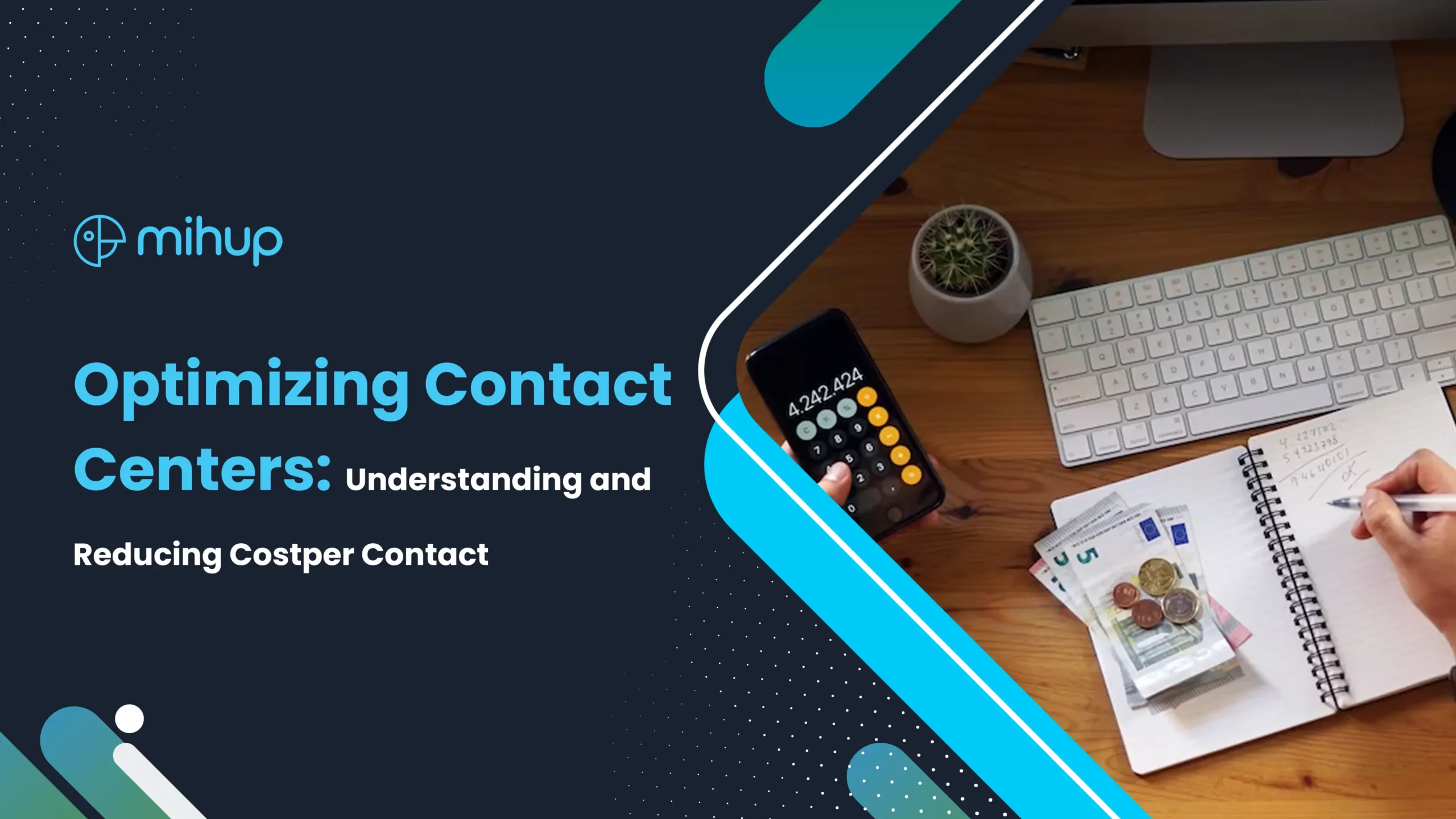Contact centers play a pivotal role in connecting businesses with their customers. As technology advances and consumer expectations evolve, contact centers must adapt to ensure effective and efficient communication. One crucial metric that contact centers closely monitor is the “Cost per Contact.”
What is Cost per Contact?
Cost per Contact serves as a pivotal Key Performance Indicator (KPI) for contact centers, offering a comprehensive assessment of the financial implications associated with customer interactions. This metric quantifies the average expenditure incurred by a contact center during each engagement with a customer. Its calculation extends beyond direct labor costs, encapsulating a spectrum of financial components. Chief among these are the expenses tied to the workforce, encompassing salaries, benefits, and training programs for customer service representatives.
Moreover, Cost per Contact incorporates technology expenses arising from the adoption and maintenance of essential tools such as customer relationship management (CRM) systems and communication platforms. Additionally, indirect costs, often termed as overheads, play a role in this metric, encompassing expenditures like rent, utilities, and administrative costs associated with facilitating customer inquiries, addressing issues, or fulfilling requests. By encompassing these diverse elements, Cost per Contact provides a nuanced understanding of the economic aspects inherent in sustaining effective customer interactions within a contact center environment. It serves as a vital tool for businesses seeking to strike a balance between operational efficiency and financial prudence in their customer service endeavors.
The CPI Formula
The calculation of Cost per Contact, abbreviated as CPI, is derived by dividing the total expenses accrued by a contact center during a defined timeframe by the corresponding number of customer interactions within that period. This formula unveils a precise insight into the average cost incurred by the contact center to manage each interaction effectively.
To illustrate, consider a scenario where a contact center accumulates ₹10,000 in costs over a month while handling 1,000 customer interactions during that same period. By applying the CPI formula (CPI = Total Cost / Number of Interactions), the result is ₹10. This implies that, on average, the contact center expends ₹10 for each customer interaction. This metric is instrumental in gauging the economic efficiency of the contact center’s operations, allowing businesses to assess and refine their strategies to achieve a balanced and cost-effective approach to delivering quality customer service. The CPI formula thus serves as a valuable tool for organizations striving to optimize their operational costs while maintaining high standards in customer interactions.
Understanding the Components of Cost per Contact
Labor Costs
The most substantial component within the Cost-per-contact metric revolves around labor expenses. This category includes the salaries and benefits attributed to critical personnel such as customer service representatives and supervisors, all of whom play vital roles in managing and facilitating customer interactions. Efficient workforce management practices and targeted training programs prove instrumental in optimizing these labor costs. By ensuring that the workforce is both skilled and well-equipped to handle diverse customer needs, businesses can contribute significantly to the overall reduction of the Cost per Contact.
Technology Expenses
Contact centers heavily rely on technological infrastructure to streamline operations and enhance the quality of customer service. Expenses associated with the implementation and maintenance of crucial technologies, including customer relationship management (CRM) systems and communication platforms, contribute significantly to the overall Cost per Contact. Strategic investment in cutting-edge tools is essential for maintaining a balance between operational efficiency and financial prudence. Effectively leveraging technology not only improves customer service but also plays a pivotal role in shaping a more favorable Cost per Contact.
Overheads
While not directly tied to individual customer interactions, overheads are a critical factor contributing to the overall calculation of the Cost per Contact. These indirect costs encompass essential elements such as rent, utilities, and administrative expenses. Although they may not be immediately apparent in the context of a single customer interaction, overheads play a significant role in the broader financial landscape of the contact center. A comprehensive understanding and strategic management of overheads are imperative for businesses aiming to optimize their Cost per Contact and achieve a more balanced and cost-effective approach to delivering exceptional customer service.
What is the Cost per Customer Contact?
The Cost per Customer Contact stands as a pivotal subset within the broader framework of Cost per Contact, honing in on the intricacies of expenses associated with individual interactions. Unlike the broader metric, which encompasses all customer interactions collectively, the Cost per Customer Contact zeros in on the financial implications of engaging with a specific customer.
This metric is indispensable for businesses seeking a nuanced understanding of the financial landscape tied to individual customer interactions. By isolating the costs incurred for each engagement, companies can tailor their customer service strategies to the unique needs and preferences of individual customers. This personalized approach not only enhances customer satisfaction but also contributes to increased loyalty and positive brand perception.
The Cost per Customer Contact serves as a powerful tool for businesses aiming to strike a delicate balance between delivering exceptional customer service and managing operational costs. By gaining insights into the specific financial implications of each interaction, companies can implement targeted strategies to optimize the customer experience while simultaneously ensuring cost-effectiveness. This metric, therefore, plays a strategic role in guiding businesses toward a customer-centric approach that aligns with their financial objectives.
Reducing Your Cost per Contact
Implementing Self-Service Options
Empowering customers with the ability to find answers independently through self-service options is a game-changer. Platforms like Frequently Asked Questions (FAQs), knowledge bases, and automated systems enable customers to resolve simple issues without agent intervention. This approach significantly reduces the workload on contact center agents, leading to a decrease in incoming calls and inquiries. The result is a more efficient and cost-effective resolution process.
Effective Use of Technology
Investing in advanced technologies, such as conversational intelligence and AI-enabled Speech Analytics, can revolutionize customer service. These tools automate routine and repetitive tasks, allowing human agents to focus on more complex customer issues that require empathy and problem-solving skills. Automation not only enhances operational efficiency but also contributes to a noticeable reduction in labor costs associated with handling routine inquiries.
Read more about AI-enabled speech analytics technology in our blog: Speech Analytics: What Is It And What It Can Do?
You can also visit our page to learn more about Mihup Interaction Analytics, our speech analytics tool.
Optimizing Workforce Management
Efficient workforce management is a linchpin in controlling labor costs. Implementing strategies like skill-based routing ensures that calls are directed to agents with the most relevant expertise, resulting in quicker and more accurate resolution of customer inquiries. Additionally, leveraging forecasting and scheduling tools aligns staffing levels with anticipated call volumes, preventing the pitfalls of both overstaffing and understaffing.
Continuous Training and Development
A well-trained and skilled customer service team is an invaluable asset. Investing in continuous training programs keeps agents abreast of product knowledge, customer service best practices, and emerging trends. This proactive approach contributes to a more proficient and effective customer service team, reducing the likelihood of follow-up interactions and ultimately lowering the Cost per Contact.
Monitoring and Analyzing Metrics
Regularly monitoring key performance metrics, including the Cost per Contact, is essential for identifying areas of improvement. Analyzing data on customer interactions, response times, and resolution rates provides valuable insights that can be used to refine processes and reduce overall costs. This data-driven approach ensures that strategies are informed and aligned with the overarching goal of cost reduction.
Outsourcing and Offshoring
For some businesses, outsourcing customer service functions or leveraging offshoring opportunities can be a strategic and cost-effective move. By tapping into a global talent pool, companies gain access to skilled agents at lower labor costs. This approach, when implemented judiciously, contributes significantly to reducing the overall Cost per Contact while maintaining or even enhancing service quality.
In the realm of contact centers, understanding and effectively managing the Cost per Contact is crucial for businesses striving to provide exceptional customer service while maintaining financial sustainability. By strategically implementing self-service options, leveraging technology, optimizing workforce management, investing in continuous training, and monitoring key metrics, businesses can take significant steps toward reducing their Cost per Contact.
In a rapidly evolving business landscape, the ability to adapt and optimize operations is paramount. Reducing the Cost per Contact not only enhances the bottom line but also contributes to improved customer satisfaction and loyalty. As businesses navigate the complexities of customer service, a focus on cost efficiency in contact centers will undoubtedly remain a key factor in achieving long-term success.





